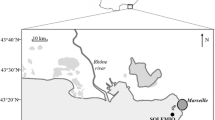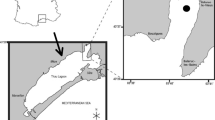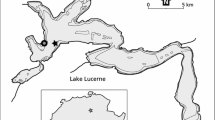Abstract
Biomass and activity of planktonic bacteria were investigated during a one year study in a shallow sandpit lake. The shallowness of the lake helped keep the water column homogeneous regarding bacterioplankton. Small free-living bacteria (0.03 µm3 cell−1) dominated the populations throughout the period studied. Bacterial abundances varied from 1 to 11 × 106 cells ml−1. Kinetic parameters (V max, K + S and T) were determined with 14C labelled compounds (glucose and amino acids mixture). V max values were high and averaged 0.056 and 0.050 µgCl−1 h−1 for glucose and amino acids respectively. Maximal V max values were observed in summer at the highest temperatures, but also in early spring. T values were much greater in winter. K + S values were significantly higher for amino acids (3 µg Cl−1) than for glucose (1 µg Cl−1). A low percentage of mineralization (about 25% for both tracers) could be the expression of the high growth efficiency expected when bacteria are growing at the expense of low molecular weight compounds as phytoplankton exudates.
Similar content being viewed by others
References
Albright, L. J., 1977. Heterotrophic dynamics in the lower Frase River, its estuary and Georgia Strait, British Columbia, Canada. Mar. Biol. 39: 203–211.
Amblard, C., 1986. Les nucléotides adényliques: intérêts pour l'étude de la biomasse, de l'activité métabolique et de la structure des peuplements phytoplanctoniques lacustres. Thèse Doct. Etat, Univ. Clermont 2, Clermont-Ferrand: 1–37.
Andersson, A., U. Larsson & A. Hagström, 1986. Size selective predation by a microflagellate on pelagic bacteria. Mar. Ecol. Prog. Ser. 33: 51–57.
Azam, F., T. Fenchel, J. S. Gray, L. A. Meyer-Reil & F. Thingstad, 1983. The ecological role of water-column microbes in the sea. Mar. Ecol. Prog. Ser. 10: 257–263.
Azam, F. & R. E. Hodson, 1981. Multiphasic kinetics for D-glucose uptake by assemblages of natural marine bacteria. Mar. Ecol. Prog. Ser. 6: 213–222.
Bell, W. H. & E. Sakshaug, 1980. Bacterial utilization of algal extracellular products. 2. A kinetic study of natural populations. Limnol. Oceanogr. 25: 1021–1033.
Billen, G., C. Joiris, J. Wijnant & G. Gillain, 1980. Concentration and microbiological utilization of small organic molecules in the Schelf Estuary, the Belgian coastal zone of the North Sea and the English Channel. Estuar. Coast. Shelf Sci. 17: 207–212.
Bjørnsen, P. K., 1986. Bacterioplankton growth yield in continuous seawater cultures. Mar. Ecol. Prog. Ser. 30: 191–196.
Cole, J. J. & G. E. Likens, 1979. Measurements of mineralization of phytoplankton detritus in an oligotrophic lake. Limnol. Oceanogr. 24: 541–547.
Cole, J. J., G. E. Likens & D. L. Strayer, 1982. Photosynthetically produced dissolved organic carbon: an important carbon source for phytoplankton bacteria. Limnol. Oceanogr. 27: 1080–1090.
Crawford, C. C., J. E. Hobbie & K. L. Webb, 1974. The utilization of free amino acids by estuarine microorganisms. Ecology 55: 551–563.
Daley, R. J. & J. E. Hobbie, 1975. Direct counts of aquatic bacteria by a modified epifluorescence technique. Limnol. Oceanogr. 20: 875–882.
Delattre, J. M., R. Delesmont, M. Clabaux, C. Oger & H. Leclerc, 1979. Bacterial biomass, production and heterotrophic activity of the coastal seawater at Gravelines (France). Oceanol. Acta 2: 317–324.
Elliott, J. M., 1977. Some methods for statistical analysis of samples of benthic invertebrates. F.B.A. Sci. Publ. No. 25, 1–160.
Fenchel, T. M., 1982d. Ecology of heterotrophic microflagellates. 4. Quantitative occurence and importance as bacterial consumers. Mar. Biol Prog. Ser. 9: 35–42.
Fenchel, T. M. & B. B. Jorgensen, 1977. Detritus food chains of aquatic ecosystems: the role of bacteria. In Advances in microbial ecology. Plenum Press, New York: 1–58.
Fergusson, R. L. & W. G. Sunda, 1984. Utilization of amino acids by planktonic marine bacteria: Importance of clean technique and low substrate additions. Limnol. Oceanogr. 29: 258–274.
Furhman, J. A., J. W. Ammerman & F. Azam, 1980. Bacterioplankton in the coastal euphotic zone: Distribution, activity and possible relationships with phytoplankton. Mar. Biol. 50: 201–207.
Fuhrman, J. A. & F. Azam, 1980. Bacterioplankton secondary production estimates for coastal waters of British Columbia, Antarctica, and California. Appl. Envir. Microbial. 39: 1085–1095.
Furhman, J. A. & F. Azam, 1982. Thymidine incorporation as a measure of heterotrophic bacterioplankton production in marine surface waters: Evaluation and field results. Mar. Biol. 66: 109–120.
Garnier, J., 1989. Peuplement phytoplanctonique et bactéries hétrotrophes d'un lac peu profond (Lac de Créteil; région parisienne). Production, fonctionnement, évolution. Thèse Doct. ès Sci. (Ecologie). Univ. Paris VI, 331 pp.
Garnier, J. & D. Benest, 1990. Seasonal coupling between phyto- and bacterioplankton in a sand pit lake (Créteil Lake, France). In: Bonin, D. J. & Golterman, H. L. (eds), Fluxes Between Trophic Levels and Through the Water-Sediment Interface. Kluwer Academic Publishers, Dordrecht: 71–77 (Reprinted from Hydrobiologia 207).
Gocke, K.,1977. Comparison of methods for determining the turnover times of dissolved organic compounds. Mar. Biol. 42: 131–141.
Goulder, R., 1986. Seasonal variation in the abundance and heterotrophic activity of suspended bacteria in two lowland rivers. Freshwat. Biol. 16: 21–37.
Güde, H., 1988. Direct and indirect influence of crustacean zooplankton on bacterioplankton of Lake Constance. Hydrobiologia 159: 63–73.
Güde, H., B. Haibel & H. Müller, 1985. Development of planktonic bacterial populations in a water column of Lake Constance (Bodensee-Obersee). Arch. Hydrobiol. 105:59–77.
Hagström, A., U. Larson, P. Hörstedt & S. Normak, 1979. Frequency of dividing cells, a new approach to the determination of bacterial growth rates in aquatic environments. Appl. Envir. Microbiol. 37: 805–812.
Hamilton, R. D. & J. E. Preslan, 1970. Observations on heterotrophic activity in the Eastern Tropical Pacific. Limnol. Oceanogr. 15: 395–401.
Hobbie, J. E. & C. C. Crawford, 1969. Respiration corrections for bacterial uptake of dissolved organic compounds in natural waters. Limnol. Oceanogr. 14: 528–532.
Hobbie, J. E., R. J. Daley & S. Japser,1977. Use of nuclepore filters for counting bacteria by fluorescence microscopy. Appl. Envir. Microbiol. 33: 1225–1228.
Jones, J. G. & B. M. Simon, 1975. An investigation of errors in direct counts of aquatic bacteria by epifluorescence microscopy, with reference to a new method for dyeing membrane filters. J. Appl. Bact. 39: 317–329.
Jørgensen, N. O. G. & M. Søndergaard, 1984. Are dissolved amino acids free? Microb. Ecol. 10: 301–316.
King, G. M. & T. Berman, 1984. Potential effects of isotopic dilution on apparent respiration in 14C heterotrophy experiments. Mar. Ecol. Prog. Ser. 19: 175–180.
Kirchman, D., 1983. The production of bacteria attached to particles suspended in a freshwater pond. Limnol. Oceanogr. 28: 858–872.
Kirchman, D. & R. Mitchell, 1982. Contribution of particle bound bacteria to total microheterotrophic activity in five ponds and two marshes. Appl. Envir. Microbiol. 43: 200–209
Krambeck, C., 1979. Applicability and limitations of Michaelis-Menten equation in microbial ecology. Arch. Hydrobiol. Beih. Ergeb. Limnol. 12: 64–76.
Lacroix, G., Ph. Boët, J. Garnier, F. Lescher-Moutoué, R. Pourriot & P. Testard, 1989. Controlling factors of the planktonic community in the shallow Lake of Créteil. Int. Revue ges. Hydrobiol. 74: 353–370.
Linley, E. A. S. & R. C. Newell, 1984. Estimates of bacterial growth yields based on plant detritus. Bull. Mar. Sci. 35: 409–425.
Marvalin, O., 1988. Abondance, biomasse, activité et relations trophiques des communautés bactériennes hétérotrophes du lac d'Aydat (Puy de Dôme). Contribution à l'étude du fonctionnement des systèmes aquatiques. 1–157. These de Doctorat de l'Univ. Blaise Pascal Clermont II.
Marxen, J., 1981. Bacterial biomass and bacterial uptake of glucose in polluted and unpolluted groundwater of sandy and gravelly deposits. Verh. Int. Ver. Limnol. 21: 1371–1375.
Newell, S. Y. & R. R. Christian, 1981. Frequency of dividing cells as an estimator of bacterial productivity. Appl. Envir. Microbiol. 42: 23–31.
Novistky, J. A. & R. Y. Morita, 1976. Morphological characterization of small cells resulting from nutrient starvation of a psychrophilic marine vibrio. Appl. Envir. Microbiol. 32: 617–622.
Novitsky, J. A. & R. Y. Morita, 1977. Survival of a psychrophilic marine vibrio under long term nutrient starvation. Appl. Envir. Microbiol. 33: 635–641.
Overbeck, J., 1975. Distribution pattern of uptake kinetic responses in a stratified eutrophic lake (Plußsee ecosystem study 4). Verh. Int. Ver. Limnol. 19: 2600–2615.
Overbeck, J., 1979. Studies on heterotrophic functions and glucose metabolism of microplankton in Plußsee. Arch. Hydrobiol. Beih. Ergebn. Limnol. 13: 56–76.
Parsons, T. R. & J. D. H. Strickland, 1962. On the production of particulate organic carbon by heterotrophic processes in sea water. Deep-Sea Res. 8: 211–222.
Pedrós-Alió, C. & T. D. Brock, 1983. The importance of attachment to particles for planktonic bacteria. Arch. Hydrobiol. 98: 374–379.
Rai, H. & G. Hill, 1982. Establishing the pattern of heterotrophic bacterial activity in three Central Amazonian lakes. Hydrobiologia 86: 121–126.
Reynolds, C. S., 1984. The ecology of freshwater phytoplankton. E. Beck, H. J. B. Birks, and E. F. Connor (eds), 1–384. Cambridge studies in Ecology.
Reynolds, C. S., S. W. Wiseman, B. M. Godfrey & C. Butterwick, 1983. Some effects of artificial mixing on the dynamics of phytoplankton population in large limnetic enclosures. J. Plankton Res. 5: 203–234.
Riemann, B., 1983. Biomass and production of phyto- and bacterioplankton in eutrophic Lake Tystrup, Denmark. Freshwat. Biol. 13: 389–398.
Riemann, B., J. Fuhrman & F. Azam, 1982a. Bacterial secondary production in freshwater measured by 3H-thymidine incorporation method. Microb. Ecol. 8: 101–114.
Riemann, B., M. Søndergaard, H. H. Schierup, S. Bosselman, G. Christiensen, J. hansen & B. Nielsen, 1982b. Carbon metabolism during a spring Diatom bloom in the eutrophic Lake Mossø. Int. Revue Ges. Hydrobiol. 67: 145–185.
Servais, P., 1988. Mesure de la production bacterienne par incorporation de thymidine tritiée. Revue Franç. Sci. Eau 1: 217–237.
Schwaerter, S., M. Søndergaard, B. Riemann & L. M. Jensen, 1988. Respiration in eutrophic lakes: the contribution of bacterioplankton an bacterial growth yield. J. Plankton Res. 10: 515–531.
Sieburth, J., 1979.Sea microbes. Oxford University Press, New York.
Simon, M. & F. Azam, 1989. Protein content and protein synthesis rates of planktonic marine bacteria. Mar. Ecol. Prog. Ser. 51: 201–213.
Sommer, U., 1981. The role of r- and κ-selection in the succession of phytoplankton in Lake Constance. Acta Oecol. 2: 327–342.
Tamminen, T., 1982. Winter microbial activity in Lake Tuusulanjärvi. Hydrobiologia 86: 109–113.
Testard, P., 1983. Le lac de Créteil (région parisienne): un lac de sablière peu profond. In LamotteM. et BourlièreF. (eds), Problèmes d'écologie, Ecosystèmes limniques, 1–54. Masson, Paris.
Torrela, F. & R. Y. Morita, 1981. Microcultural study of bacterial size changes and microcolony and ultramicrocolony formation by heterotrophic activity. Appl. Envir. Microbiol. 41: 518–527.
Trousselier, M., M. Albat, P. André & B. Baleux, 1985. Dénombrements directs des bactéries dans les milieux aquatiques par microscopie et épifluorescence: distribution et précision des mesures. Revue Franç. Sci. Eau 4: 35–49.
Turpin, D. H. & P. J. Harrison, 1980. Cell size manipulation in natural marine planktonic, diatom communities. Can. J. aquat. Sci. 37: 1193–1195.
Vaccaro, R. F. & H. W. Jannasch, 1967. Variations in uptake kinetics for glucose by natural populations in sea-water. Limnol. Oceanogr. 12: 540–542.
Wetzel, R. G, 1975. Limnology. W.B. Saunders Compagny (ed.), 1–743.
Williams, P. J.Le B., 1973. The validity of the application of simple kinetic analysis to heterogeneous microbial populations. Limnol. Oceanogr. 18: 159–165.
Williams, P. J.Le B., T. Berman & O. Holm-Hansen, 1976. Amino acid uptake and respiration by marine heterotrophs. Mar. Biol. 35: 41–47.
Wright, R. T., 1978. Measurement and significance of specific activity in the heterotrophic bacteria of natural waters. Appl. Envir. Microbiol. 36: 297–305.
Wright, R. T. & J. E. Hobbie, 1965. The uptake of organic solutes in lake water. Limnol. Oceanogr. 10: 22–28.
Wright, R. T. & J. E. Hobbie, 1966. Use of glucose and acetate by bacteria and algae in aquatic ecosystems. Ecology 47: 447–453.
Wright, R. T. & N. M. Shah, 1977. The trophic role of glycolic acid in coastal seawater. 2. Seasonal changes in concentration and heterotrophic use in Ipswich Bay, Massachussetts, USA. Mar. Biol. 43: 257–263.
Author information
Authors and Affiliations
Rights and permissions
About this article
Cite this article
Garnier, J., Benest, D. Planktonic bacterial biomass and seasonal pattern of the heterotrophic uptake and respiration of glucose and amino acids in the shallow sandpit lake of Créteil (Paris Suburb, France). Hydrobiologia 209, 191–202 (1991). https://doi.org/10.1007/BF00015342
Received:
Revised:
Accepted:
Issue Date:
DOI: https://doi.org/10.1007/BF00015342




